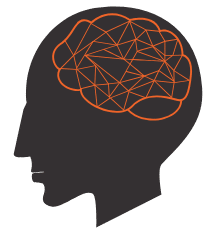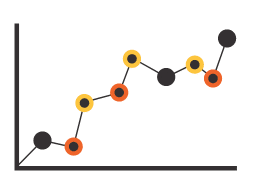
It’s easy to take most of our five primary senses for granted.
We assume our hands will touch, our noses will smell, our tongues will taste, our ears will hear, and our eyes will see.
Yet, behind the scenes, there are myriad processes that must take place before we can enjoy life as we know it. This is especially true with our vision.
There are intricate pathways in our brain’s visual cortex responsible for engaging this sense. These are critical to everyday interactions, whether we’re looking at a dinner menu or interpreting data at the workplace.
Have you ever wondered about the journey that information takes as it travels from unknown to understood?
Today, we’re exploring this process in-depth, helping to shed light on how vision works. We’ll also share how business leaders can capitalize on this function to create deeper, more meaningful learning tools.
Ready to learn more? Let’s get started!

How is Vision Processed in the Brain?
Think of the most advanced computer system in the world. Consider the disparate components that must speak to each other to make sure every input creates the desired output.
Your vision is more layered, elaborate, and complex than that.
Before we can see light, movement, and objects and understand their logical place in our world, key neural mechanisms must first activate. How does this complicated system function? Let’s take a closer look.

The Process of Visual Perception
There’s a reason we all fumble around in the dark.
Light is the trigger that catalyzes our vision. After it hits our eye’s cornea and lens, it travels to the photoreceptor cells on our retina. This is the retina’s outer nuclear layer.
These cells convert that light into electrochemical signals that our brain can process. The types of signals are divided by their two respective shapes. They include:
- Rods
- Cones
The average human retina has around 130 million photoreceptor cells. There are around 20 times the number of rods as cones.
Rod Cells
While we might have a harder time getting around when the lights are low, we can still make out objects and perceive their meaning. We have rod cells to thank for this ability.
Rod cells are linked to our night vision, responding best to dim light. These cylindrical formations are between 40 to 50 microns long.
Want to learn to see better at night? Try focusing your gaze on the side of the object you’re observing. Rod cells are found primarily in your retina’s peripheral regions and can better activate when you redirect your gaze this way.
Cone Cells
On the other hand, cone cells are more concentrated in the central part of your retina, also called your “fovea.”
While rod cells help you navigate in low-light settings, these work best in brighter light. As such, cone cells are responsible for more intellectual tasks including reading and analysis. They also enable color vision.
Cone cells will respond to red, blue, and green lights in different ways and can be sub-categorized as such. When all three types work in tandem, it allows us to see and perceive color.

From Photoreceptors to Ganglions
Once the rod and cone signals pass through your retina’s layer of photoreceptor cells, their journey is far from over. From there, they will continue to pass through the other layers of your retina.
The next place they’ll travel to is the retina’s inner nuclear layer. This layer includes bipolar, horizontal and amacrine cells.
Bipolar Cells
Bipolar cells are responsible for accepting the information contained within the rods and cones and then transmitting it to the third layer of ganglion cells.
Horizontal Cells and Amarine Cells
Working laterally, horizontal cells and amacrine cells facilitate communication and interaction within your retina. Their complex receptive fields make it possible for us to see contrast within objects. Because of these connections, we can notice shadows, sharp edges, and more.
The final stage is the ganglion cell layer.
Here, these cells gather information and signals from the other two layers and send it as a message to your brain via your optic nerve.

The Role of the Optic Nerve
Visual perception occurs in your brain’s cerebral cortex. Before this can happen, however, information must travel there.
As soon as you see an object, cod and rod signals begin traveling through your retinal layers. When they’re processed at the ganglion cell layer, they enter your brain through your optic nerve.
A group of nerve fibers that resembles a cable, this nerve mostly consists of retinal ganglion cell (RGC) axons. It first transports visual information to your brain’s thalamus.
In addition to your thalamus, your optic nerve also takes retinal signals to two other regions of your brain, including your:
- Pretectum
- Superior Colliculus
Pretectum
Your brain’s pretectum is a nucleus (a group of cells). It’s responsible for changing the size of your pupils in response to light intensity. If you’ve ever wondered why your pupils get bigger in the dark, this is where the change originates!
Superior Colliculus
Have you ever watched someone’s eyes as they tried to pan a long gaze across a big room? If this process were to happen smoothly across this visual landscape, the image would be a blurry mess.
Instead, saccadic eye movement helps it happen in phases.
Your brain’s superior colliculus is responsible for helping your eyes move in short bursts of semi-still images, called saccades. When they’re stitched together, we don’t notice these jumps. Instead, we see the illusion of a smooth scan.

Critical Thalamus Processing
Your thalamus is a small structure located right above your brain stem. It’s responsible for separating your cerebral cortex from your midbrain and transferring sensory and motor signals from the latter to the former.
As the thalamus receives visual signals from your retina, it can send them to your cerebral cortex. There, they’re transformed into meaningful objects through visual perception.
In which part of the thalamus do the signals go?
The answer is your Lateral Geniculate Nucleus, or LGN. Located deep in the center of your brain, your LGN separates those initial retinal inputs into two parallel streams. They’re divided as follows:
- Stream 1: Contains color and fine structure
- Stream 2: Contains contrast and motion
In all, the LGN consists of six layers of cells. Stream 1 cells comprise the top four layers. Small in size, they’re known as the parvocellular layers.
Then, Stream 2 cells comprise the bottom two layers of the LGN. Larger in size, these are called the magnocellular layers.

The Primary Visual Cortex
The cells located within your LGN’s magnocellular and parvocellular layers project retinal signals to a region located all the way in the back of your brain, known as your primary visual cortex, or V1.
This is where your brain can process where objects are in space. Without this function, you’d simply see random objects scattered around your home or workplace, without understanding foreground, background, placement and more.
The primary tactic at play is called retinotopic organization. In short, this means that there’s a point-to-point network, or map, that exists between your retina and your V1.
Signals don’t travel sporadically throughout these regions. Rather, certain neighboring areas in your retina correspond to specific neighboring areas in your primary visual cortex.
These connections are required for functional vision. With them, you can see two primary dimensions: horizontal and vertical positioning.
How do you recognize the third dimension, depth?
Ocular Dominance Columns
Your V1 cortex maps depth by comparing the respective retinal signals from each of your two eyes. Within the cortex, there are stacks of cells called ocular dominance columns. These cells contain connections that create a checkerboard pattern, alternating between your left and right eye.
As each eye has a slightly different perceptive angle of any given object, your V1 can process these signals via triangulation, creating what we call depth.
Orientation Columns
In addition to ocular dominance columns that perceive depth, your V1 is also organized into orientation columns.
These columns include stacks of cells that activate according to the lines in any given orientation. They allow your primary visual cortex to understand object edges.
While this might seem like a small feat, it’s anything but. We identify and remember objects by their lines. Thus, orientation columns initiate the critical process of visual recognition.
When researchers Torsten Wiesel and David Hubel first discovered the link between information processing and V1 columnar cell organization in 1981, they were awarded the Nobel Prize!
While we can appreciate these connections as adults, it’s interesting to note that newborn babies don’t quite see what all the fuss is about. That’s because their checkerboard connections are fuzzy at birth. Out of the womb, an infant’s visual cortex is overrun with haphazard connections, a condition called hypertrophy.
Over time and with maturity, they’re able to prune these connections into defined columns. In fact, it’s the reduction (not the increase) of connections that enable babies to recognize shapes and patterns, perceive depth, and see in fine detail.

The Secondary Visual Cortex
In addition to your brain’s V1 cerebral cortex, there’s also a secondary visual cortex (V2).
While V1 is responsible for helping you perceive lines and edges, V2 helps you refine your ability to interpret color. Specifically, it helps our brains understand the concept of color constancy.
If you look at a red stop sign under various colors of illumination, it will likely still appear red to you. Your V2 is behind this phenomenon of perception.
How does it work?
Your V2 can process an object and compare it separately from its ambient illumination, subtracting out any other colors besides the one you associate with that object.
While this is fascinating, it’s important to know that your initial perception of the object is what sets the stage for this process. If you were raised from birth to see blue stop signs, you’d likely perceive them as blue under the same illuminations.

Other Visual Cortexes and Cerebral Lobes
There are other visual cortexes and regions located within your brain that serve to refine visual perception.
For instance, V3 and V4 help define your personal perceptions of color and form. In addition, your brain’s inferior temporal lobe is responsible for face and object recognition while your parietal lobe defines motion and spatial awareness.
For the most part, these higher-order vision features also hinge on past experiences and expectations. This is how we’re able to see and respond to the visual world in a split-second manner.
However, although these are deeply engrained functions, they aren’t irreversible. For instance, if you’ve ever fooled your brain by looking at an optical illusion, you’ll know that sometimes, we can push past personal expectations and influences to see something totally different.

Leveraging Visual Perception in Data Visualization
Based on what we’ve learned, we can come to one primary conclusion:
We don’t “see” data with our eyes. We see it with our brains.
Now that we’ve covered the basics of how vision operates, what are some good ways to visualize learning? In other words, how can we arrange data so that our brains are best suited to process and understand it?
The short answer is to put the information into a format that our brains can use.
Research shows that our brains are wired to process images 60,000 times quicker than text. Moreover, 90% of the data sent to our brains is visual, and 93% of all human communication is visual.
Thus, it helps to translate as much text-based information into a visual format that our brains can more easily accept and comprehend.
Quick Perception Versus Slow Cognition
In this post, we’ve covered the background of visual perception. This is the act of seeing a visual or an object. Your visual cortex is primarily responsible for this process. Located at the rear of your brain, it’s very fast and efficient.
On the other hand, there’s a second process that goes into data analysis: cognition. While perception is quick, cognition takes longer. This is the act of thinking about, analyzing, and processing information. It’s also how we establish contextual relationships and compare data.
This step takes place in your cerebral cortex, located at the front of your brain. It’s a slower, less-efficient process than visual perception.
Here’s where data visualization is key: It switches the part of our brain that’s most activated. Instead of relying on cognition, you use visual perception more. This results in quicker, more accurate decision-making and clearer understanding.

Learning to See Data Differently
Have you gotten used to staring at spreadsheets of numbers that look like a foreign language? If so, it’s time to give your cerebral cortex a break and tap into your visual cortex instead.
Data visualization can get you there.
When you’re ready to leverage the incredible power of your vision to transform how your company captures, handles and understands the information it processes, let us know. We help companies like yours transform loads of complex insights into beautiful, simple charts and graphs that are both actionable and practical. Contact us to learn more today and change your mind about how you see the world around you.
